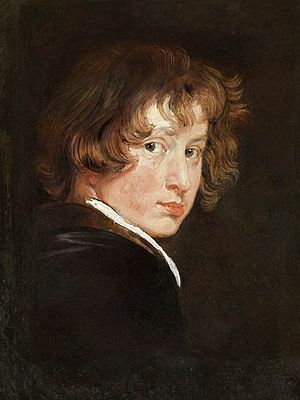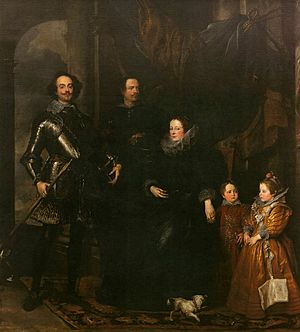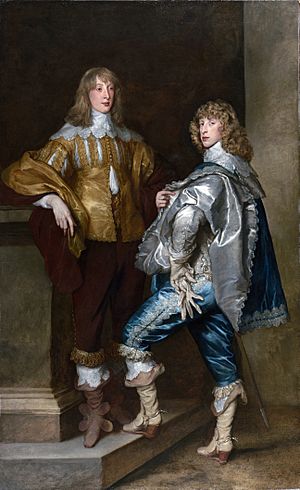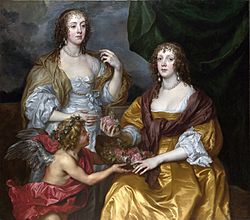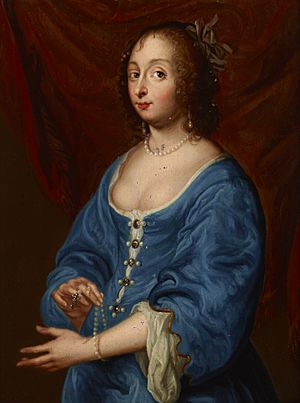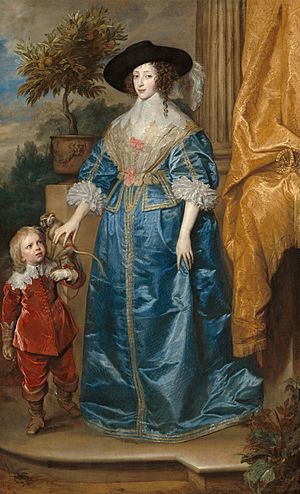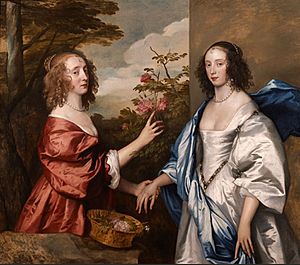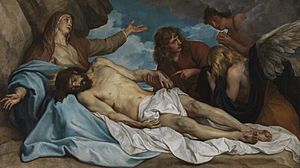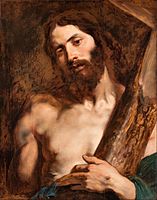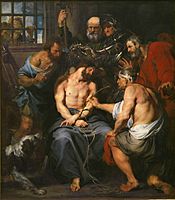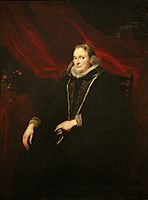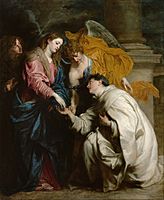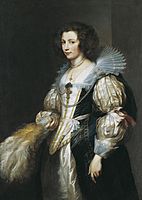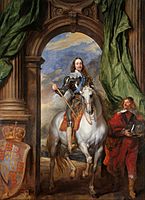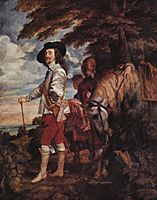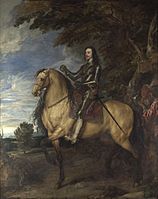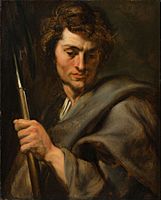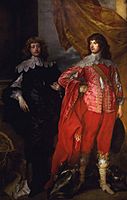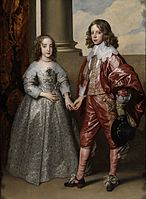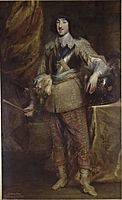Anthony van Dyck facts for kids
Quick facts for kids
Anthony van Dyck
|
|
|---|---|
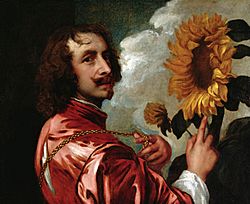
Self-Portrait with a Sunflower (after 1633)
|
|
| Born |
Antoon van Dyck
22 March 1599 |
| Died | 9 December 1641 (aged 42) |
| Nationality | Flemish |
| Education | Hendrick van Balen, Peter Paul Rubens |
| Known for | Painting |
| Movement | Baroque |
| Spouse(s) |
Mary Ruthven
(m. 1640) |
Sir Anthony van Dyck (born Antoon van Dyck, 22 March 1599 – 9 December 1641) was a famous Flemish Baroque painter. He became the most important court painter in England. Before that, he was very successful in the Spanish Netherlands and Italy.
Anthony was the seventh of twelve children. His father, Frans van Dyck, was a rich silk merchant in Antwerp. Anthony started painting at a young age. He became a successful independent painter in his late teens. In 1618, he became a master in the Antwerp painters' guild. Around this time, he worked in the studio of Peter Paul Rubens, a leading painter. Rubens greatly influenced Van Dyck's art.
Van Dyck worked in London for a few months in 1621. Then he went back to Flanders for a short time. After that, he traveled to Italy, where he stayed until 1627, mostly in Genoa. In the late 1620s, he finished his well-known Iconography series. These were etchings of portraits, mostly of other artists. He spent five years in Flanders after returning from Italy. From 1630, he was the court painter for Archduchess Isabella, who governed Flanders. In 1632, King Charles I of England asked him to return to London. There, he became the main court painter.
Van Dyck and his friend Diego Velázquez were among the first very talented painters to work mainly as court portrait artists. They changed how portraits were painted. Van Dyck is best known for his portraits of important people, especially King Charles I and his family. His style greatly influenced English portrait painting for the next 150 years. He also painted scenes from myths and the Bible. He was a skilled artist who also innovated in watercolour and etching.
His influence continues even today. The Van Dyke beard is named after him. King Charles I made him a knight during his lifetime. Van Dyck was buried in St Paul's Cathedral, which shows how important he was when he died.
Contents
Life and Work
Early Life and Training
Antoon van Dyck, as he was known in Flanders, was born in Antwerp. His parents were wealthy, and he was the seventh of twelve children. His father, Frans van Dyck, was a silk merchant. His mother was Maria Cupers. Anthony was baptized on March 23, 1599.
His artistic talent was clear from a very early age. By 1609, he was studying painting with Hendrick van Balen. Around 1615, he became an independent painter. He even set up a workshop with his younger friend Jan Brueghel the Younger. By age fifteen, he was already a very skilled artist, as shown in his Self-portrait from 1613–14. On October 18, 1617, he was accepted into the Antwerp painters' Guild of Saint Luke as a master.
Within a few years, he became the main assistant to Peter Paul Rubens. Rubens was the most important artist in Antwerp and all of Northern Europe. Rubens often used other artists and had a large workshop. Rubens had a huge influence on the young Van Dyck. Rubens even called the nineteen-year-old Van Dyck "the best of my pupils."
It's not fully clear how their relationship started. Some think Van Dyck was Rubens's student from about 1613. This is because Van Dyck's early work doesn't show much of Van Balen's style. But there is no clear proof of this.
Rubens was very dominant in Antwerp, which was a smaller city then. This might explain why Van Dyck spent most of his career abroad. Even though he returned to Antwerp sometimes. In 1620, Rubens's contract for the ceiling of the Carolus Borromeuskerk church mentioned Van Dyck. It said Van Dyck was one of the "discipelen" (students) who would paint based on Rubens's designs. Unlike Van Dyck, Rubens worked for many European courts but didn't stay with just one.
Time in Italy
In 1620, George Villiers encouraged Van Dyck to visit England. He worked for King James I of England and received £100. In London, he saw the work of Titian in the collection of the Earl of Arundel. Titian's use of color and soft way of shaping forms changed Van Dyck's style. It gave him new artistic ideas to add to what he learned from Rubens.
After about four months, he went back to Flanders. Then, in late 1621, he left for Italy, where he stayed for six years. There, he studied the great Italian masters. He also started a successful career painting portraits. He acted like an important person, which annoyed other Northern artists in Rome. One writer, Giovan Pietro Bellori, said Van Dyck acted like a nobleman. He wore fancy clothes, a hat with feathers, gold chains, and had servants.
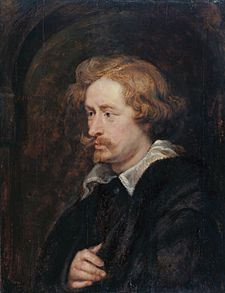
He mostly lived in Genoa. But he also traveled to other cities. He stayed for some time in Palermo, Sicily. In 1624, he was quarantined there during a serious plague. During this time, he painted an important series of works about Saint Rosalia, the city's plague saint. His paintings showed a young woman with blonde hair in a Franciscan robe. She reached down towards Palermo, which was in danger. These images became the standard way to show the saint. They greatly influenced Italian Baroque painters.
For the rich families of Genoa, he created a new style of full-length portraits. These paintings showed very tall, graceful figures looking down at the viewer with great pride. He used ideas from Veronese, Titian, and Rubens's own time in Genoa. In 1627, he returned to Antwerp. He stayed there for five years. He painted more friendly portraits that still made his Flemish clients look very stylish. A large group portrait he painted of twenty-four city councilors of Brussels was destroyed in 1695. He was very charming to his clients. Like Rubens, he could easily mix with noble and royal families. This helped him get many painting jobs. By 1630, he was known as the court painter for Archduchess Isabella. During this time, he also created many religious works, including large altarpieces, and began making prints.
London and Death
King Charles I loved art very much. He saw painting as a way to show the importance of his rule. In 1628, he bought a huge art collection from the Duke of Mantua. Since becoming king in 1625, he had tried to bring top foreign painters to England. In 1626, he convinced Orazio Gentileschi to move to England. Later, Orazio's daughter Artemisia and some of his sons joined him. Rubens was a special target. He finally came in 1630 on a diplomatic trip, which included painting. Later, Rubens sent Charles more paintings from Antwerp. Rubens was treated very well during his nine-month visit and was made a knight. Charles's court portrait painter, Daniel Mytens, was not as exciting. Charles was very short, less than 5 feet tall, which was a challenge for a portrait artist.
Van Dyck stayed in touch with the English court. He helped King Charles's agents find paintings. He sent some of his own works, like a self-portrait (1623) with Endymion Porter, one of Charles's agents. He also sent his Rinaldo and Armida (1629) and a religious painting for the Queen. He had also painted Charles's sister, Queen Elizabeth of Bohemia, in The Hague in 1632. In April of that year, Van Dyck returned to London. The court immediately welcomed him. He was knighted in July and received a yearly payment of £200. He was called the principal painter to the King and Queen.
He was supposed to be well paid for his paintings, but King Charles didn't pay his yearly pension for five years. He also lowered the price of many paintings. Van Dyck was given a house on the River Thames at Blackfriars. This area was just outside the City of London, so he didn't have to deal with the Worshipful Company of Painter-Stainers' rules. He also had rooms at Eltham Palace as a country home. His partner, Margaret Lemon, managed these homes.
The King and Queen often visited his Blackfriars studio. A special path was even built to make it easier for them to visit. They hardly sat for any other painter while Van Dyck was alive. He became very successful in England. He painted many portraits of the King and Queen Henrietta Maria, and their children. Many portraits were made in several versions. These were sent as gifts to other countries or given to the King's supporters. It's thought that Van Dyck painted forty portraits of King Charles himself. He also painted about thirty of the Queen, nine of the Earl of Strafford, and many of other court members. He painted many people at court, and also himself and his partner, Margaret Lemon.
In England, he developed a new style. It combined relaxed elegance with a quiet authority in his subjects. This style would influence English portrait painting until the late 1700s. His portraits of Charles on horseback updated the grand style of Titian's Emperor Charles V. But even more special is his portrait of Charles off his horse in the Louvre. In this painting, Charles looks naturally like a king. He strolls casually, seeming more like a gentleman than a king. His portraits created the classic image of "Cavalier" style and clothing. However, many of his important noble clients, like Lord Wharton and the Earls of Bedford, Northumberland, and Pembroke, actually supported the Parliament in the English Civil War. This war started soon after Van Dyck's death.
In 1638, King Charles granted Van Dyck denizenship, which meant he had many rights like a British citizen. On February 27, 1640, he married Mary Ruthven. They had one daughter together. Mary was the daughter of Patrick Ruthven, who called himself Lord Ruthven. She was a lady-in-waiting to the Queen in 1639–40. The King might have arranged this marriage to keep Van Dyck in England. He had spent most of 1634 in Antwerp and returned the next year. In 1640–41, as the Civil War was about to begin, he spent several months in Flanders and France. In 1640, he traveled with Prince John Casimir of Poland after he was freed from a French prison.
A letter from August 13, 1641, said Van Dyck was getting better after a long illness. In November, Van Dyck's health worsened. He returned to England from Paris, where he had gone to paint Cardinal Richelieu. He died in Blackfriars, London, on December 9, 1641. This was the same day his daughter Justiniana was baptized. He was buried on December 11 in St Paul's Cathedral. His body and tomb were destroyed in the Great Fire of London in 1666.
Portraits and Other Works
In the 1600s, people wanted portraits more than other types of art. Van Dyck tried to convince King Charles to order a large series of paintings about the history of the Order of the Garter. These were meant for the Banqueting House, Whitehall, where Rubens had already painted the large ceiling. A sketch for one wall painting still exists. But by 1638, Charles didn't have enough money to continue. This was a problem Van Dyck faced, unlike Velázquez. However, Van Dyck's daily life was not filled with small court duties like Velázquez's. In his last years, Van Dyck tried to get the job to paint the Grande Gallerie of the Louvre in Paris, but he was not successful.
A list of history paintings Van Dyck made in England still exists. It was put together by his biographer Bellori, using information from Sir Kenelm Digby. None of these works seem to remain, except for Eros and Psyche which he painted for the King. But many other religious and mythological works do survive. While they are very beautiful, they don't reach the same level as Velázquez's history paintings. Van Dyck's earlier works are very similar to Rubens's style. However, some of his paintings from Sicily are unique.
Van Dyck's portraits made people look more flattering than Velázquez's. When Sophia, who later became Electress of Hanover, met Queen Henrietta Maria in Holland in 1641, she wrote: "Van Dyck's handsome portraits had given me such a beautiful idea of all English ladies. I was surprised to find that the Queen, who looked so fine in painting, was a small woman raised up on her chair, with long skinny arms and teeth like defense works sticking out of her mouth..."
Some art critics have said Van Dyck changed a developing, tougher English portrait style. This style was seen in painters like William Dobson, Robert Walker, and Isaac Fuller. Instead, Van Dyck's style led to what became elegant but sometimes plain portraits by his followers, like Lely or Godfrey Kneller. However, the common view has always been more positive. Jonathan Richardson wrote in 1715: "When Van Dyck came here, he brought Face-Painting to us; ever since then... England has excelled all the world in that great part of art." It is said that Thomas Gainsborough on his deathbed said, "We are all going to heaven, and Van Dyck is of the Company."
Van Dyck made a small number of landscape drawings and watercolours in England. These were important in bringing the Flemish watercolor landscape tradition to England. Some are studies that appear in the backgrounds of his paintings. But many are signed and dated and were likely seen as finished artworks to be given as gifts. Several of the most detailed ones are of Rye, a port for ships going to Europe. This suggests Van Dyck drew them casually while waiting for good wind or tides.
Printmaking

Van Dyck likely started his Iconography series when he was in Antwerp after returning from Italy. This became a very large series of prints showing half-length portraits of important people of his time. He made drawings, and for eighteen of the portraits, he himself etched the heads and main outlines of the figures. Then, an engraver would finish the work. Before Van Dyck, portrait etching hardly existed. With his work, it suddenly reached its highest point.
He left most of the printmaking to skilled specialists. They engraved the prints based on his drawings. His etched plates were probably not published until after his death, and early versions are very rare. Most of his plates were printed after only his part of the work was done. Some exist in later states after engraving was added, sometimes covering up his etching. He continued to add to the series until he left for England, and probably added Inigo Jones while in London.
The series was a huge success, but it was his only project in printmaking. Painting portraits likely paid better, and he was always in demand. When he died, there were eighty plates made by others, with fifty-two of them being artists, plus his own eighteen. A publisher bought the plates. They continued to be printed for centuries, with the plates being fixed when they wore out. The series grew to over two hundred portraits by the late 1700s. In 1851, the plates were bought by the Calcographie du Louvre.
The Iconography was very influential as a business model for making copies of prints. Series of portrait prints, now forgotten, were extremely popular until photography came along. The importance of this series was huge. It provided many images that portrait painters all over Europe used for the next couple of centuries. Van Dyck's brilliant etching style, which used open lines and dots, was very different from that of Rembrandt, another great portrait artist in prints. It didn't have much influence until the 1800s. Then, it greatly influenced artists like Whistler in the last major period of portrait etching.
Studio
Van Dyck's success meant he had a large workshop in London. It became "almost like a factory for portraits." A visitor said that Van Dyck usually only made a drawing on paper. An assistant would then make it larger on canvas. Van Dyck himself would then paint the head. The clothes the client wanted to be painted in were left at the studio. Often, the unfinished painting was sent to artists who specialized in painting clothes. In his last years, these collaborations with his studio assistants sometimes led to a slight drop in the quality of his work.
Also, many copies were made by his workshop, or by professional copyists and later painters, without him touching them. By the 1800s, a huge number of paintings were said to be by him, just like with Rembrandt and Titian. However, most of his assistants and copyists couldn't match his refined style. So, compared to many masters, art historians usually find it easy to agree on which paintings are truly by him. Museum labels are now mostly updated. Paintings in country houses might be less certain in some cases.
The few names of his assistants that are known are Dutch or Flemish. He probably preferred to use trained Flemings. This is because there wasn't much art training in England at that time. Van Dyck's huge influence on English art doesn't come from a tradition passed down through his students. In fact, we can't find a clear link between his studio and any important English painter. The Dutchman Adriaen Hanneman (1604–1671) returned to his home in The Hague in 1638. He became the leading portrait painter there.
The Flemish painter Pieter Thijs studied in Van Dyck's workshop as one of his last students. He became a very successful portrait and history painter in his home city of Antwerp.
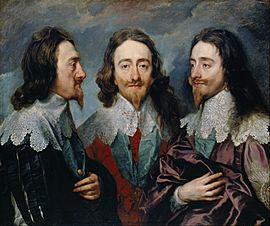
Legacy
Much later, the styles worn by his models gave names to certain things. The Van Dyke beard is a sharply pointed and trimmed goatee, popular for men in his time. The van Dyke collar is a wide collar across the shoulders, richly edged with lace. During the time of King George III, a general "Cavalier" fancy-dress costume called a Van Dyke was popular. Gainsborough's The Blue Boy wears such a Van Dyke outfit. In 1774, Derby porcelain advertised a figure of "the King in a Vandyck dress."
Many different colors used in painting have been called "Vandyke brown." Some of these colors existed before Van Dyck, and it's not clear if he used any of them. Van Dyke brown is also an early photographic printing process that uses the same color.
When Van Dyck was made a knight in 1632, he changed his name to Vandyke to sound more English.
Collections
The British Royal Collection still has many of his paintings, with a total of twenty-six works. The National Gallery, London has fourteen works. The Museo del Prado (Spain) has twenty-five works, including Self-portrait with Endymion Porter and The Metal Serpent. The Louvre in Paris has eighteen works. The Alte Pinakothek in Munich, the National Gallery of Art in Washington, D.C., the Museum of Fine Arts, Boston, and the Frick Collection all have examples of his portrait style. Wilton House still holds the works he did for one of his main supporters, the Earl of Pembroke. This includes his largest work, a huge family group portrait with ten main figures. Spanish museums also have many of his works. The Thyssen-Bornemisza Museum has the Portrait of Jacques Le Roy and a Crucified Christ. The Bilbao Fine Arts Museum has a great Lamentation before the dead Christ. In 2008, Patrimonio Nacional of Spain got back a Martyrdom of Saint Sebastian and returned it to The Escorial Monastery. The Real Academia de Bellas Artes de San Fernando has found a long-stored painting of its own, adding to another, The Virgin with the Child with the repentant sinners. In December 2017, a Virgin with Child at The Museum Cerralbo, once thought to be by Mateo Cerezo, was confirmed as an original Van Dyck after careful study. Finally, The Museum of Fine Arts of Valencia owns an Equestrian Portrait of Don Francisco de Moncada.
Tate Britain held an exhibition called Van Dyck & Britain in 2009. In 2016, the Frick Collection in New York had an exhibition called "Van Dyck: The Anatomy of Portraiture." This was the first major show of his work in the United States in over twenty years.
The estate of the Earl Spencer at Althorp has a small collection of Van Dycks. This includes War and Peace (a portrait of Sir George Digby, 2nd Earl of Bristol with William Russell, 1st Duke of Bedford). This is the most valuable painting in the collection and the Earl's favorite.
Artworks Returned to Owners
In 2017, a painting by Van Dyck called Portrait of Adriaen Hendriksz Moens was returned to the family of Jacques Goudstikker. This artwork had been taken during a difficult historical period. After World War II, a group called the Monuments Men returned the painting to the Netherlands. It was supposed to go back to the Jewish family who owned it. Instead, it was sold to an art dealer in London, who then sold it to Rudolf August Oetker. Oetker's family later returned the painting to Goudstikker's heirs.
Gallery
-
Christ Crowned with Thorns (c. 1620) in the Prado
-
Nicholas Lanier, 1628
-
Rest on the Flight into Egypt, ca. 1630, Alte Pinakothek, Munich
-
Katherine, Countess of Chesterfield, and Lucy, Countess of Huntingdon, c. 1636–40, oil on canvas, Yale Center for British Art
-
Princess Mary, Daughter of Charles I, about 1637, Museum of Fine Arts, Boston
-
Portrait of Sir George Digby, 2nd Earl of Bristol, English Royalist politician with William Russell, 1st Duke of Bedford ("War and Peace"), 1637, Althorp
-
Portrait of Jacques Le Roy, 1631. Thyssen-Bornemisza Museum, Madrid.
-
Portrait of Mary, daughter of Charles I with her husband the Prince of Orange, 1641. Rijksmuseum, Amsterdam.
See also
 In Spanish: Anton van Dyck para niños
In Spanish: Anton van Dyck para niños
- List of paintings by Anthony van Dyck


